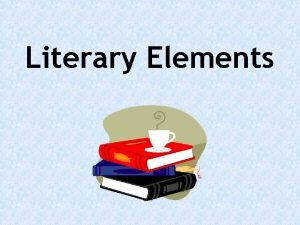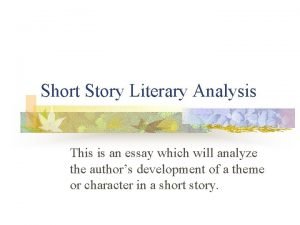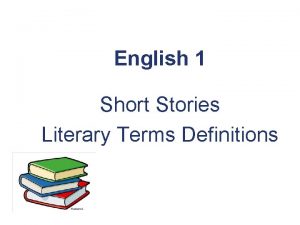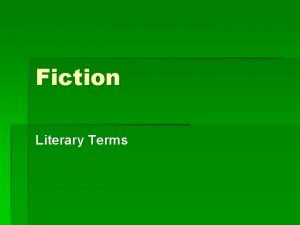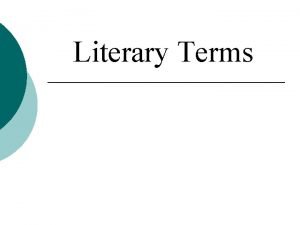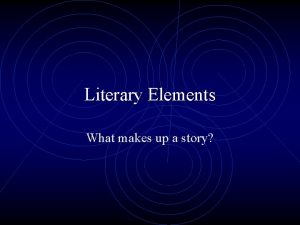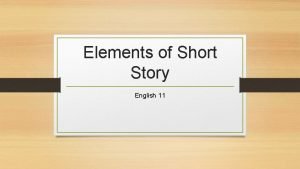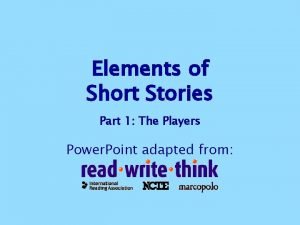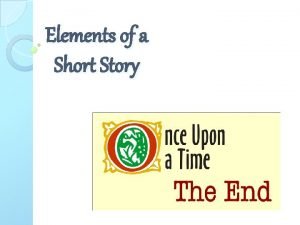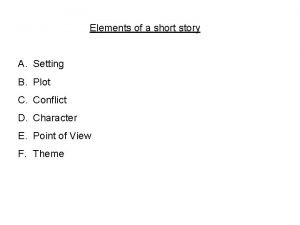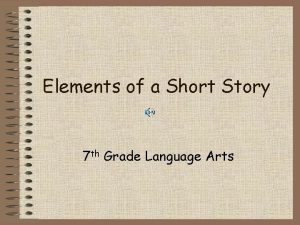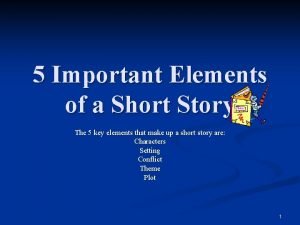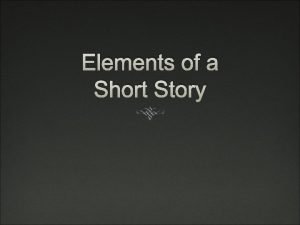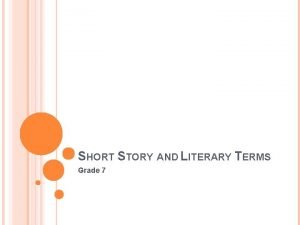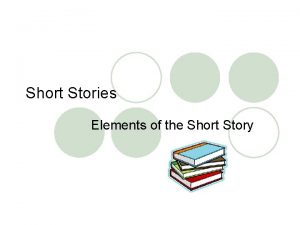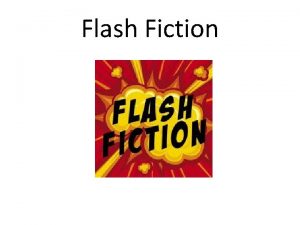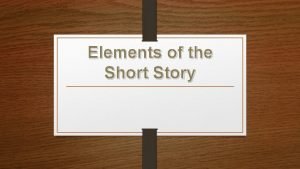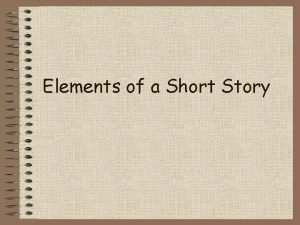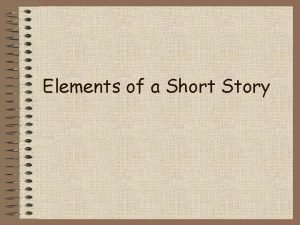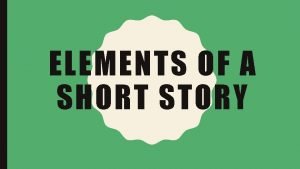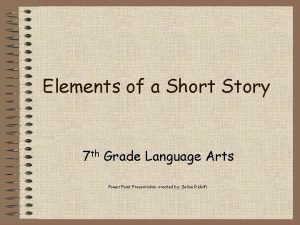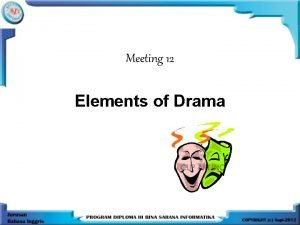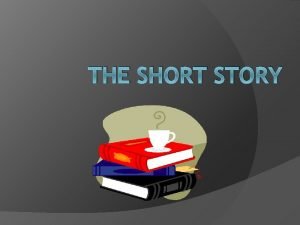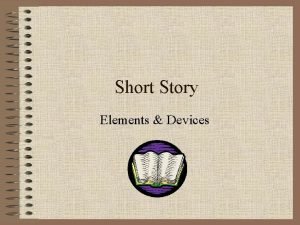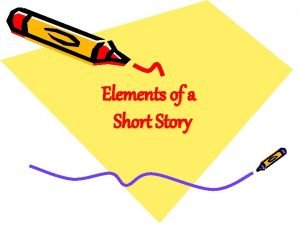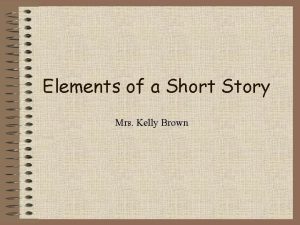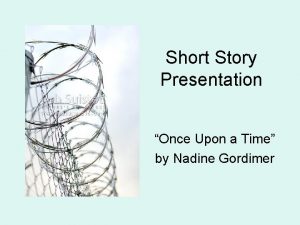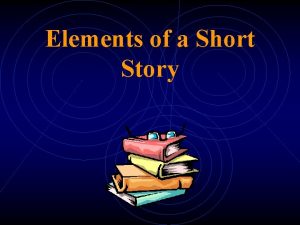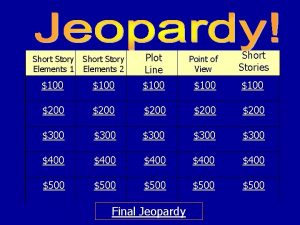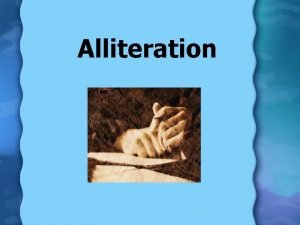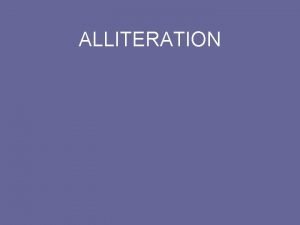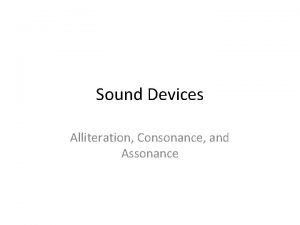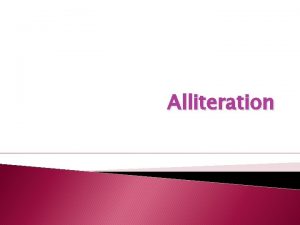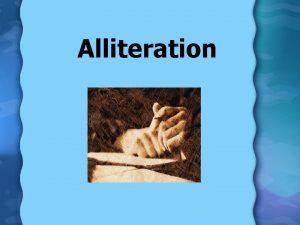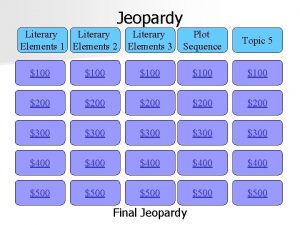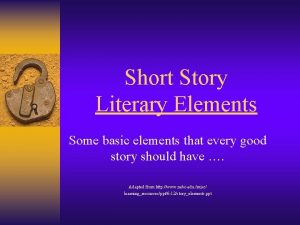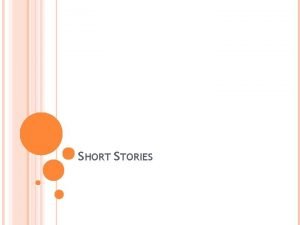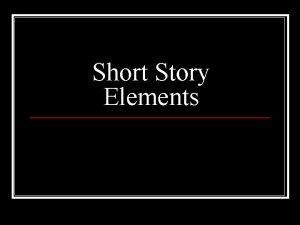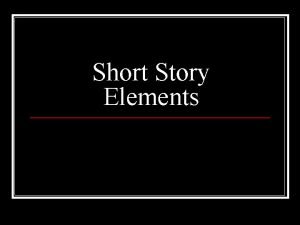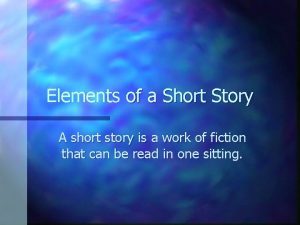Short Story Literary Elements Alliteration Alliteration is the

































- Slides: 33

Short Story/ Literary Elements

Alliteration • Alliteration is the repetition of consonant sounds generally at the beginning of words, or, within neighboring words in a sentence. Examples: Peter Piper picked a peck of pickled peppers. Wide-eyed and wondering while we wait for others to waken.

Antagonist • Force or character working against the main character. Protagonist • Main character, may be a hero or heroine, with whom the audience tends to identify.

Allusion • A reference to a well-known person, place, event, or literary work, often used to help make a comparison. Examples: • “I was surprised his nose was not growing like Pinocchio’s. ” • “When she lost her job, she acted like a Scrooge, and refused to buy anything that wasn’t necessary. ” • “He was a real Romeo with the ladies. ”

Character • Person, animal, or creature in a literary work.

Character • Round characters are complex and multidimensional, like real people. • Flat characters are one dimensional and superficial; they can be described in a single sentence. • A Dynamic Character changes as a result of the events of the story. • A Static Character changes very little or not at all through the literary work.

Climax • Turning point in the story

Conflict • Conflict is the problem struggle in a story. or • There are four general types of conflict in literature: Ø Character versus Character Ø Character versus Nature Ø Character versus Society Ø Character versus Self

Dialect • Dialect is the way of speaking that is specific to of a certain geographical area or a certain group of people. • Commonly brought to mind are New Yorkers, the Bostonians, and the Southern Dialect.

Dialogue • Dialogue is a conversation between two or more characters.

Exposition • Found at the beginning of a story and used to introduce background information about events, settings, characters, to the reader

Falling Action • The parts of the story after the climax and before the resolution.

Flashback • Flashback is an interruption in the present action of a plot to show events that happened at an earlier time.

Foreshadowing • Foreshadowing is the use of clues or hints to suggest events that will occur later in the plot.

Hyperbole (Figurative Language) • Hyperbole is an exaggerated statement. Examples: She’s said so on several million occasions. It must’ve weighed a ton.

Idiom (Figurative Language) • An idiom is an expression peculiar to a particular language that means something different from the literal meaning of the words. • Hold your tongue is an idiom for don’t speak. • Bury your head in the sand is an idiom for ignore a difficult situation.

Imagery • Imagery is when words or language is used to appeal to one or all of the five senses – sight, touch, taste, smell or sound.

Irony and Dramatic Irony • Irony is the contrast between expectation (what is expected ) and reality (what actually occurs). • Dramatic Irony occurs when the audience or reader knows something a character does not know. • In “The Diary of Anne Frank”, the audience knows the fate of its characters. The characters, however, continue to discuss what they will do when they are free – Anne wants to ride a bike and go to Paris. Our knowledge that this will not occur is dramatic irony.

Metaphor (Figurative Language) • Metaphors are comparisons between two things without using the words like or as. Examples: The road was a ribbon of moonlight. She was a flower among women.

Mood/Atmosphere • Mood and Atmosphere are used interchangeably to refer to the “emotional feeling the reader receives from the literature. • The Mood or Atmosphere might be scary, happy, sad, romantic, nostalgic, or exciting.

Onomatopoeia (Figurative Language) • Onomatopoeia is the use of words that imitate sounds Examples: Buzz! Crackle!

Personification (Figurative Language) • Personification is when human qualities are given to an animal, an object or an idea. Examples: The little dog laughed. The cow winked at the little girl.

Plot • Plot is the sequence of events that happen in a story.

Plot Components Climax: the turning point, the most intense moment—either mentally or in action middle Rising Action: the series of conflicts and crisis in the story that lead to the climax. It is when something starts to happen beginning Exposition: the start of the story, the situation before the action starts Falling Action: all of the action which follows the climax end • Resolution: is the conclusion of the action when everything comes together.

Point of View • Point of view is how the story is told by the narrator or author; either first, second, or third person

Point of View First Person: The narrator is a character, often the main character, of the story. The first person narrator refers to him or herself as “I. ” Second person: The narrator tells the story to another character using "you, " so that the story is being told through the addressee's point of view. Second person is the least commonly used. Third Person: Characters are referred to as "he" and "she" in third person. In this case the narrator (who may be indistinguishable from the author) is not a character in the story.

Point of View Omniscient: This is the all-knowing narrator. The omniscient point of view sees everything and hears everything, and is able to see into the minds of multiple characters.

Rising Action • A series of events between the exposition and the climax that create suspense, interest and tension in a literary work

Setting • Time, place, and physical characteristics of where a story takes place.

Simile (Figurative Language) • Simile is when a comparison is made between two unlike things, using a word such as like, as, than or resembles. • Similes are most often direct comparisons between two unlike things using the words like and as. • Examples: Timothy’s arms were like iron. My love is like a red, red rose. Her face was as round as a pumpkin.

Theme • a central message, idea, or concern that is expressed in a literary work • • Examples Never give up It is better to give than receive The truth will set you free Success comes from hard work

Tone • Tone is the attitude a writer/author takes towards his or her subject, characters and audience. Examples: humorous, passionate, sincere, solemn, and anger.

Fiction • Fiction is a prose account that is made up rather than true. • Fiction refers to novels and short stories. Nonfiction • Nonfiction is prose writing that deals with real people, things, events and places.
 Long and short
Long and short Short story literary elements
Short story literary elements Introduction for short story
Introduction for short story Literary elements and definitions
Literary elements and definitions Literary analysis example for a short story
Literary analysis example for a short story Short story literary definition
Short story literary definition The lottery characters protagonist and antagonist
The lottery characters protagonist and antagonist What is a brief work of fiction
What is a brief work of fiction Short story in literary terms
Short story in literary terms Elements of a short story video
Elements of a short story video Five element of story
Five element of story Elements of a short story powerpoint
Elements of a short story powerpoint Objective in a story
Objective in a story Short story with complete elements
Short story with complete elements Elements of a short story grade 7
Elements of a short story grade 7 Key elements of short story
Key elements of short story Identify the elements of short story. *
Identify the elements of short story. * Elements of a short story grade 7
Elements of a short story grade 7 Parts of a short
Parts of a short Fiction
Fiction Diagram elements of a short story
Diagram elements of a short story Short story elements definitions
Short story elements definitions Short story elements definitions
Short story elements definitions Elements of a story definition
Elements of a story definition Example of short story with elements
Example of short story with elements What is comedy in drama
What is comedy in drama Protagonist in cinderella
Protagonist in cinderella Example of short story with elements pdf
Example of short story with elements pdf Rising action in cinderella
Rising action in cinderella Elements of short story
Elements of short story What is a short story
What is a short story Short story for presentation
Short story for presentation Narrative elements
Narrative elements Hát kết hợp bộ gõ cơ thể
Hát kết hợp bộ gõ cơ thể

